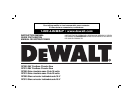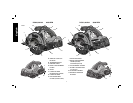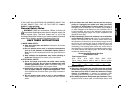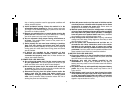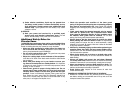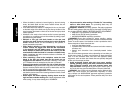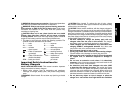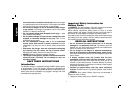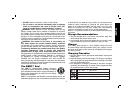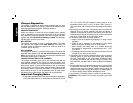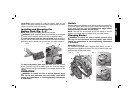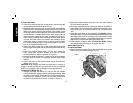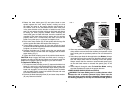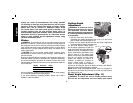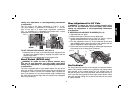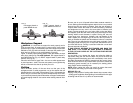
English
4
e) Under abusive conditions, liquid may be ejected from
the battery, avoid contact. If contact accidentally occurs,
flush with water. If liquid contacts eyes, additionally seek
medical help. Liquid ejected from the battery may cause
irritation or burns.
6) SERVICE
a) Have your power tool serviced by a qualified repair
person using only identical replacement parts. This will
ensure that the safety of the power tool is maintained.
Additional Safety Rules for
Circular Saws
DANGER: Keep hands away from cutting area and blade. Keep
your second hand on auxiliary handle or motor housing. If both
hands are holding the saw, they cannot be cut by the blade.
• Keep your body positioned to either side of the blade, but
not in line with the saw blade. KICKBACK could cause the
saw to jump backwards (see KICKBACK).
• Do not reach underneath the work. The guard can not protect
you from the blade below the work.
• Adjust the cutting depth to the thickness of the workpiece.
Less than a full tooth of the blade teeth should be visible below
the workpiece.
• Never hold piece being cut in your hands or across your
leg. Secure the workpiece to a stable platform. It is important
to support the work properly to minimize body exposure, blade
binding, or loss of control.
• Check lower guard for proper closing before use. Do not
operate saw if lower guard does not move freely and close
instantly. Never clamp or tie the lower guard into the open
position. If saw is accidentally dropped, lower guard may be
bent. Raise the lower guard with the Retracting Handle and
make sure it moves freely and does not touch the blade or any
other part, in all angles and depths of cut.
• Check the operation and condition of the lower guard
spring. If the guard and the spring are not operating properly,
they must be serviced before use. Lower guard may operate
sluggishly due to damaged parts, gummy deposits, or a buildup of
debris.
• Lower guard should be retracted manually only for special
cuts such as “Pocket Cuts” and “Compound Cuts.” Raise
lower guard by Retracting Handle. As soon as blade enters
the material, lower guard must be released. For all other
sawing, the lower guard should operate automatically.
• Always observe that the lower guard is covering the blade
before placing saw down on bench or floor. An unprotected,
coasting blade will cause the saw to walk backwards, cutting
whatever is in its path. Be aware of the time it takes for the blade
to stop after switch is released.
• Hold tool by insulated gripping surfaces when performing an
operation where the cutting tool may contact hidden wiring.
Contact with a “live” wire will make exposed metal parts of the tool
“live” and shock the operator.
• When ripping always use a rip fence or straight edge guide.
This improves the accuracy of cut and reduces the chance for
blade binding.
• Always use blades with correct size and shape (diamond
vs. round) arbor holes. Blades that do not match the mounting
hardware of the saw will run eccentrically, causing loss of control.
• Never use damaged or incorrect blade washers or bolts. The
blade washers and bolt were specially designed for your saw, for
optimum performance and safety of operation.
• Avoid cutting nails. Inspect for and remove all nails from
lumber before cutting.
CAUSES AND OPERATOR PREVENTION OF KICKBACK
• Kickback is a sudden reaction to a pinched, bound or misaligned
saw blade, causing an uncontrolled saw to lift up and out of the
workpiece toward the operator.



